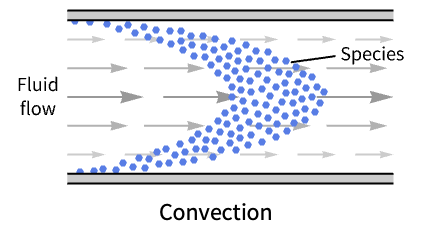ConvectionPDETerm[vars,β]
represents a convection term ![]() with convection coefficient
with convection coefficient ![]() and model variables vars.
and model variables vars.
ConvectionPDETerm[vars,β,pars]
uses model parameters pars.


ConvectionPDETerm
ConvectionPDETerm[vars,β]
represents a convection term ![]() with convection coefficient
with convection coefficient ![]() and model variables vars.
and model variables vars.
ConvectionPDETerm[vars,β,pars]
uses model parameters pars.
Details



- Convection terms are used in a number of domains such as thermodynamics, acoustics, structural mechanics and fluid dynamics.
- Convection is also known as advection.
- Convection with a convection coefficient
 is the process of transport of the dependent variable
is the process of transport of the dependent variable  due to a bulk movement:
due to a bulk movement: - ConvectionPDETerm returns a differential operators term to be used as a part of partial differential equations:
- ConvectionPDETerm can be used to model convection equations with dependent variable
 , independent variables
, independent variables  and time variable
and time variable  .
. - Stationary model variables vars are vars={u[x1,…,xn],{x1,…,xn}}.
- Time-dependent model variables vars are vars={u[t,x1,…,xn],{x1,…,xn}} or vars={u[t,x1,…,xn],t,{x1,…,xn}}.
- The convection term
 in context with other PDE terms is given by:
in context with other PDE terms is given by: - During convection, the medium in which the convection happens is the transport mechanism, in contrast to diffusion where the medium remains stationary.
- The convection coefficient
 has the following form:
has the following form: -
{β1,…,βn} 
vector 
- For a system of PDEs with dependent variables {u1,…,um}, the convection represents:
- The convection term in context systems of PDE terms:
- The convection coefficient
 is a tensor of rank 3 of the form
is a tensor of rank 3 of the form  where each submatrix
where each submatrix  is a vector of length
is a vector of length  that is specified in the same way as for a single dependent variable.
that is specified in the same way as for a single dependent variable. - A symbolic convection coefficient can be specified through a VectorSymbol. »
- The conservative convection coefficient
 can depend on time, space, parameters and the dependent variables.
can depend on time, space, parameters and the dependent variables. - The coefficient
 does not affect the meaning of NeumannValue.
does not affect the meaning of NeumannValue. - All quantities that do not explicitly depend on the independent variables given are taken to have zero partial derivative.
- The ConservativeConvectionPDETerm is closely related.


Examples
open all close allBasic Examples (4)
Scope (10)
Define a symbolic convection term:
Define a stationary dependent convection term with a symbolic vector convection coefficient:
Define a stationary dependent convection term with a symbolic vector convection coefficient replaced:
Define a time-dependent convection term with a symbolic vector convection coefficient replaced:
Define a 1D axisymmetric time-independent convection term:
Apply Activate to the term:
Define a time-independent 2D convection term:
Define a nonlinear time-independent 2D convection term:
Define a nonlinear time-dependent 2D convection term:
Applications (3)
Use DiffusionPDETerm to model species diffusion under a dam. Set up the region:
Find the concentration of species under the dam. Construct the model:
Visualize the species concentration:
Extend a Stokes-flow model to a Navier–Stokes flow model. Define a Stokes-flow model:
Possible Issues (2)
A convection term with a 0-flow velocity field evaluates to 0:
A symbolic convection coefficient needs to be of sufficient length:
The way to specify the symbolic vector convection coefficient is through a VectorSymbol:
Substitute a VectorSymbol with an actual value:
An alternative is to specify the symbolic convection coefficient as a vector:
Related Guides
Text
Wolfram Research (2020), ConvectionPDETerm, Wolfram Language function, https://reference.wolfram.com/language/ref/ConvectionPDETerm.html (updated 2025).
CMS
Wolfram Language. 2020. "ConvectionPDETerm." Wolfram Language & System Documentation Center. Wolfram Research. Last Modified 2025. https://reference.wolfram.com/language/ref/ConvectionPDETerm.html.
APA
Wolfram Language. (2020). ConvectionPDETerm. Wolfram Language & System Documentation Center. Retrieved from https://reference.wolfram.com/language/ref/ConvectionPDETerm.html
BibTeX
@misc{reference.wolfram_2025_convectionpdeterm, author="Wolfram Research", title="{ConvectionPDETerm}", year="2025", howpublished="\url{https://reference.wolfram.com/language/ref/ConvectionPDETerm.html}", note=[Accessed: 18-December-2025]}
BibLaTeX
@online{reference.wolfram_2025_convectionpdeterm, organization={Wolfram Research}, title={ConvectionPDETerm}, year={2025}, url={https://reference.wolfram.com/language/ref/ConvectionPDETerm.html}, note=[Accessed: 18-December-2025]}